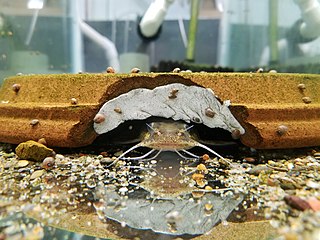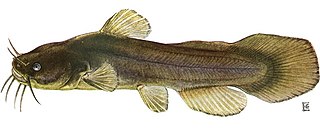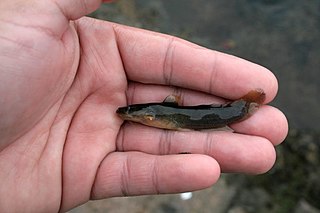
Madtoms are freshwater catfishes of the genus Noturus of the family Ictaluridae. It is the most species-rich family of catfish in North America, native to the central and eastern United States, and adjacent parts of Canada. Their fin spines contain a mild venom with a sting comparable to that of a honey bee.

The yellowfin madtom is a species of fish in the family Ictaluridae endemic to the southeastern United States. Historically, the yellowfin madtom was widespread throughout the upper Tennessee River drainage, but was thought to be extinct by the time it was formally described.

The Carolina madtom is an endangered species of fish in the family Ictaluridae. It is endemic to North Carolina. It is a small catfish, reaching a maximum length of nearly five inches. Described in the late-1800s by ichthyologists Jordan and Meek, this fish is the only madtom that is endemic to North Carolina, as indicated by its common name.

The frecklebelly madtom is a species of fish in the family Ictaluridae endemic to the United States. Madtoms are in the genus Noturus, which is a group of catfish prevalent in North America. In 2023, the Upper Coosa River distinct population segment (DPS) of N. munitus was listed as federally threatened under the Endangered Species Act of 1973.
The pygmy madtom is a species of fish in the family Ictaluridae endemic to the United States, in only two known regions of Tennessee. Madtoms are the smallest members of the catfish family. Members of the genus Noturus can be distinguished by their small size, unusually long adipose fin, and rounded caudal fin. Most specimens have been collected over shallow, fine gravel shoals with moderate to swift flow, usually near the stream bank.
Noturus flavus, the stonecat, is a North American freshwater catfish of the family Ictaluridae. The common name is due to its habit of hiding near or under stones in fast-moving water.

The tadpole madtom is a species of fish in the family Ictaluridae. It is native to Canada and the United States.

The chucky madtom is a critically endangered freshwater fish endemic to the U.S. state of Tennessee.
The elegant madtom is a fish native to Tennessee, Alabama, and Kentucky, and is one of twenty-nine species of madtom. It prefers to live in small rivers and gravel-bottomed creeks. The average lifespan of the elegant madtom is two years.
The mountain madtom is a North American species of temperate freshwater fish belonging to the Noturus genus of the family Ictaluridae. The species was first described to the United States National Museum by Professors Jordan and Gilbert in the Big Pigeon River. The mountain madtom has a body that is characterized as being robust, and by the toxic sting that is associated with their pectoral and dorsal spines. Currently, the Pigeon River Recovery Project is working to try to restore the mountain madtom population that was lost in fisheries. Aside from the Pigeon River Recovery Project, there is little management being applied to this species, and it is currently listed on the threatened species list for the state of Tennessee.

Noturus exilis, also called the slender madtom, is a species of the catfish family Ictaluridae. Ictaluridae includes bullheads, madtoms, channel catfish, and blue catfish. Noturus exilis is found in the central portion of the Mississippi River basin, but is most abundant in Ozarkian streams. Slender madtoms occur west of the Mississippi River in the Ozarks of Oklahoma, Arkansas, and Missouri north to southern Wisconsin and Minnesota. It also occurs east of the Mississippi River in the uplands of Alabama, Tennessee, and Kentucky in the Tennessee, Cumberland, and Green drainages. Nelson first described Noturus exilis in 1876. The slender madtom is moderately large with a terminal to sub terminal mouth, flat head, small eyes, and black marginal bands on the median fins. Most slender madtoms are less than 90 millimetres (3.5 in). Noturus flavus and Noturus nocturnus are rather similar in shape and coloration to Norturus exilis. Slender madtoms inhabit small to medium-sized streams, in riffle and flowing pool habitats with coarse gravel to slab rock substrates. The presence of a shelter object, such as a large rock, seems to be important in habitat selection.

Noturus fasciatus is a rare freshwater fish native to the U.S. state of Tennessee. It was first described as a species separate from Noturus crypticus in 2005. It is restricted to the Duck River system and is also found in two minor tributaries on the lower section of the Tennessee River. This species dwells in small to medium-sized streams where they can be found under gravel, rubble, and slab rock. They feed mostly on insects such as: stone, cattus and mayfly larvae.
The piebald madtom is a species of madtom catfish that is found in seven river systems in the Tennessee and Mississippi coastal tributaries. The most common systems N. gladiator is found in are, the Hatchie River, Obion River, and Wolf River. This species is very susceptible to environmental changes including flow regimes, siltation in nesting sites, and poor environmental quality. The Noturus catfish reproduces from February to September and females reach sexual maturity in only one year. Current management strategies for this recently discovered species haven't been completely developed yet, but could be comparative to the management of other madtom species. Siltation in the southern portions of the rivers, inhabited by Noturus gladiator that comes from the northern aspects of the waterways is causing stress on the reproductive success due to nest suffocation. There are records as close as twenty years ago showing the species inhabiting multiple other rivers around the areas it currently inhabits. This could be a sign that the species is in a decline. There should be population surveys done on the existing habitat and water quality surveys done in the inhabited areas as well as the uninhabited neighboring areas to see what the limiting pollutant might be in the water causing habitats to shrink. The area that this species inhabits needs to be managed in a way that could see a resurgence in gladiators numbers.
Noturus hildebrandi, also known as the least madtom, is a species of catfish. Its native range stretches from the Obion River in Kentucky to the Homochitto River in Mississippi.

The brindled madtom is a small catfish of the family Ictaluridae that is native to the eastern United States.

The freckled madtom a species of freshwater madtom (catfish) found in the eastern United States. The freckled madtom is a benthic feeder mostly of invertebrates and usually inhabits waters that are medium to large in size, living mostly in riffle areas that have mostly clear waters and rocky bottoms. Its spawning season occurs from spring to early summer in riffle areas, and sexual maturation occurs after two years.
The northern madtom is a freshwater fish.

The gulf darter is a species of freshwater ray-finned fish, a darter from the subfamily Etheostomatinae, part of the family Percidae, which also contains the perches, ruffes and pikeperches. It is found in Louisiana, Mississippi, Alabama, Florida, Tennessee, and Kentucky. It is a colorful fish, males having vertical barring of red-orange and blue-green near the tail, growing to a length of about 7.8 centimeters (3.1 in). It is typically found in small and medium-sized creeks, often in very shallow water. It occurs over sandy bottoms and among aquatic vegetation such as Sparganium americanum, foraging among the plants and organic debris for insect larvae and small invertebrates. The International Union for Conservation of Nature has assessed its conservation status as being of "least concern".
The black madtom is a nocturnal, freshwater, diminutive catfish found in watersheds in Florida, Louisiana, Alabama, and Mississippi, and is one of 29 species of madtom.
The Ozark madtom is a freshwater fish endemic to the United States. It is one of 29 species of madtom.











